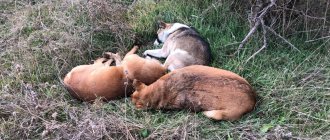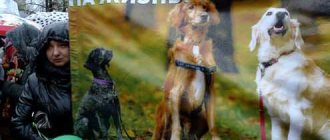ST 245 of the Criminal Code of the Russian Federation.
1. Cruel treatment of an animal for the purpose of causing it pain and (or) suffering, as well as for hooligan motives or mercenary motives, resulting in its death or injury, -
shall be punishable by a fine in the amount of up to eighty thousand rubles, or in the amount of the wages or other income of the convicted person for a period of up to six months, or by compulsory labor for a term of up to three hundred sixty hours, or by corrective labor for a term of up to one year, or by restriction of liberty for a term of up to one year. , or arrest for a term of up to six months, or imprisonment for a term of up to three years.
2. The same act committed:
a) by a group of persons, a group of persons by prior conspiracy or an organized group;
b) in the presence of a minor;
c) using sadistic methods;
d) with public demonstration, including in the media or information and telecommunication networks (including the Internet);
e) in relation to several animals, -
shall be punishable by a fine in the amount of one hundred thousand to three hundred thousand rubles, or in the amount of the wages or other income of the convicted person for a period of one to two years, or by correctional labor for a term of up to two years, or by forced labor for a term of up to five years, or by imprisonment. for a period of three to five years.
Commentary to Art. 245 Criminal Code
1. The subject of encroachment is animals, regardless of their form of ownership and their classification as wild, domestic, or kept in captivity or semi-free conditions.
2. Mandatory signs of the objective side are actions, consequences and a causal relationship between them.
Actions can be expressed in cruelty to animals (systematic beating of animals, causing pain, suffering, mutilation, wounds, leaving without food and water, self-harm, conducting unscientific experiments, etc.).
The consequences are the death of the animal or injury to it.
3. An act is punishable only if there are alternatively indicated signs of an objective or subjective side: a) sadistic methods - especially sophisticated cruelty to animals (painful killing, torture, torment, etc.), associated with the subject of the crime receiving satisfaction from torturing the animal; b) committing a crime in the presence of children under the age of 14; c) selfish motives (the motive for committing a crime is the desire to obtain material gain or get rid of material costs; d) hooligan motives (the desire of a person to show disrespect for society, moral and ethical standards, the desire to demonstrate his disdain for others).
Literature
[1] https://pravo-zoozahita.ru/problemy-kvalifikacii-i-vozbuzhdeniya-ugolovnogo-dela-po-faktam-zhestokogo-obrashheniya-s-zhivotnymi-povlekshego-ikh-gibel/ [2] Criminal Code (CC RF). System Garant, Access mode: https://base.garant.ru [3] Criminal Code (Criminal Code of the Russian Federation). System Garant, Access mode: https://base.garant.ru [4] Criminal Code (Criminal Code of the Russian Federation). System Garant, Access mode: https://base.garant.ru [5] Bogatova E. V. Prevention of cruelty to animals: monograph. Ekaterinburg: Ural Law Institute of the Ministry of Internal Affairs of Russia, 2012.P.65. [6] Criminal Code (Criminal Code of the Russian Federation). System Garant, Access mode: https://base.garant.ru [7] Guide for investigators and interrogators on the investigation of certain types of crimes. Part 2. Ed. Tsokolova O.I.. M.: Prospect. 2016.P.389. [8] https://pravo.moe/zhestokoe-obrashhenie-s-zhivotnymi-statya-nakazanie-za-izdevatelstvo/ [9] https://pravo.moe/zhestokoe-obrashhenie-s-zhivotnymi-statya-nakazanie- za-izdevatelstvo/ [10] Ibid [11] https://www.spravedlivo.ru/ [12] Makutina M., Altukhova L. The State Duma supported punishment of up to five years in prison for violence against animals [Electronic text] https:/ /www.rbc.ru/politics/22/11/2017/ [13] https://tass.ru/obschestvo/4828330
Second commentary to Art. 245 of the Criminal Code of the Russian Federation
1. The immediate object is public morality in the sphere of humane treatment of animals, which means domestic, wild and captive mammals, birds and other animals.
2. The objective side of the crime consists of actions consisting of cruelty to animals, i.e. in their systematic beatings, inhumane conditions of detention (in cold or heat), in long-term deprivation of food and water, etc.
A mandatory sign of the objective side is the consequences in the form of death or injury to an animal subjected to cruel treatment. On this basis, the organization of dog, cock and other fights that lead to the death or injury of animals should also be recognized as cruel treatment.
3. A prerequisite for criminal liability for cruelty to animals is (regardless of the motives of the perpetrator) the commission of this act using sadistic methods, which are understood as particularly humiliating methods of causing suffering to animals, or its commission in the presence of minors, i.e. . persons under the age of 14 years.
4. The crime is considered completed from the moment the consequences specified in the law occur—the death or injury of the animal.
5. The subjective side of the crime is characterized by the intent and purpose of causing pain and (or) suffering to the animal.
6. Alternatively, the mandatory features of this crime are its motives: selfish (see comments to Chapter 21) or hooliganism (see comments to Article 213 of the Criminal Code).
7. Selfish motives are typical when organizing fights between animals, when spectators are charged a fee or bets are accepted on the winner.
8. Qualified types of crime (Part 2) are characterized by its commission:
a) a group of persons, a group of persons by prior conspiracy or an organized group (see Parts 2 and 3 of Article 35 of the Criminal Code);
b) in the presence of a minor, i.e. at least one person under the age of 14; c) using sadistic methods (for example, self-mutilation, cutting off the head, burning alive);
d) with public demonstration, including in the media or information and telecommunication networks (including the Internet);
e) in relation to several animals (the same species or different species; simultaneously or sequentially).
Application in practice of legal norms on cruelty to animals
Today, more and more often, stories and reports appear in the media about terrible stories - abuse of poor defenseless animals by aggressive citizens. Such cases are simply outrageous, while the possibility of punishing the flayers according to the law is scanty.
Let's try to classify the legal norms of cruelty to animals.
Responsibility for cruelty towards representatives of the animal world is prescribed in the Code of Administrative Offenses of the Russian Federation and some regional codes of administrative offenses. For example:
In Moscow, for injury or death of an animal/animals as a result of baiting, the instigator of such a “performance” faces a fine of 4,000 to 5,000 rubles. A similar punishment is provided for injury/death of an animal as a result of other illegal acts[8].
In the Northern capital, for transporting animals that worsens their health, as well as for deliberately depriving our smaller brothers of food or drink, a fine of up to 5,000 for individuals and up to 100,000 rubles for legal entities is imposed. The same punishment faces those who conduct experiments on animals that cause pain, maim or kill them.
In Nizhny Novgorod, since 2015, administrative punishment has been provided in the form of a fine from 5,000 (individuals) to 40,000 rubles (legal entities) for cutting the tails and ears of pets, removing fangs and claws without veterinary intervention.
The Primorsky Code of Administrative Offenses provides for serious penalties for catching, keeping, and breeding animals for the purpose of killing and subsequent use (wherever) of their organs. It is also prohibited to train some pets to attack others.
And in Kuban, all pets must be microchipped, and only one owner must be listed as the owner of each of them, from whom they are responsible for the proper care and safe maintenance of the ward.
However, in many regions there is no “own” punishment for cruelty to animals. True, this does not mean that flayers can do whatever they want without fear of responsibility. The Criminal Code of the Russian Federation can always come into play.
Criminal liability under Article 245 of the Criminal Code of the Russian Federation. Article 245 has 2 parts:
The first involves bringing one person to justice, the second - a group of people. The first provides for punishment in the form of a fine of up to 80,000 rubles or correctional labor for up to 1 year, or restriction of freedom for up to 1 year. In 2010, 180 hours of compulsory labor were added to the list of penalties for this part, which in 2011 “turned” into 360 hours[9].
For the second part, the punishment is, naturally, more severe. A fine of 300,000 rubles or imprisonment for up to 2 years. Also in 2010, compulsory work was added (up to 240 hours)[10].
Recently the following information appeared in the media - an adult flayer Ivanov, in front of young schoolchildren, slowly drowned a cat in a bucket, periodically beating the animal for scratching. Judge by Art. 245. This subhuman is possible only in the case when the cat dies, unable to withstand the abuse. If, with the last of his strength, the unfortunate animal breaks free and runs away, the sadist will remain unpunished.
Situations where animal torturers escape even a meager punishment are not uncommon. And it is precisely this state of affairs that prompted animal rights activists, ordinary people and concerned government officials to introduce draft amendments to the current Criminal Code in order to toughen penalties under Article 245 and supplement its composition with other, no less terrible than murder and mutilation, illegal acts against animals.
At the federal level, in recent years, not just one, but several bills have been discussed related to the tightening of both administrative and criminal penalties for cruelty to animals. For example:
It is proposed to introduce new articles into the Code of Administrative Offenses of the Russian Federation, under which it will be possible to bring to administrative responsibility the flayers who cause not only physical, but also mental suffering to animals (deprived of food and water, kept in a confined space, etc.). It is proposed to fine individuals for this in the amount of 1,000 to 3,000 rubles, and organizations (legal entities) - half a million rubles at once.
In September 2016, the A Just Russia faction introduced changes to the Criminal Code of the Russian Federation regarding cruelty towards representatives of the animal world for the consideration of legislators. The initiators of the bill (S. Mironov and O. Mikheev) were confident that impunity in these matters provokes aggression and violence in society. They offered:
- introduce a separate standard of liability for organizers of dog fights, as well as similar events with the participation of other representatives of the animal world;
- introduce into the Criminal Code of the Russian Federation liability for the baiting of animals, resulting in injury or death of one (or both) of them;
- increase the maximum penalty of imprisonment under the current article to 6 years, and the amount of the fine to 800,000 rubles[11].
There are other legislative initiatives that provide, including:
- treatment and rehabilitation of the injured animal at the expense of the flayer;
- liability for promoting animal husbandry (in the form of a fine of up to 200,000 rubles);
- liability for an animal hit by a car (fine of 150,000 rubles);
- serious tightening of penalties for repeat crimes in the field of cruelty to animals.
It should be noted that in our country they have finally begun to revise this article of the Criminal Code of the Russian Federation. And over the past two years there have really been changes for the better.
Problems of law enforcement to protect animals from cruelty
The biggest problem, I believe, is the absolute lack of understanding on the part of the legislator of the close relationship between a person’s attitude to the surrounding world and the attitude within human society, i.e., the problem in understanding the need to protect one’s habitat, including animals, gives rise to clumsy, completely incorrect formulations of relevant legal norms. For example, the disposition of Art. 245 of the Criminal Code of the Russian Federation “Cruelty to animals” does not provide an understanding of what relates to cruelty to animals; only a listing of the occurrence of socially dangerous consequences is given - causing injury or death to an animal and the subjective side, as direct intent in the presence of motives - hooliganism, or for selfish reasons, sadistic methods or in the presence of minors.
Even a superficial analysis of this article allows us to conclude that it is quite difficult to prosecute a guilty person for cruelty to animals due to incorrect wording; Thus, it will be impossible to bring to justice a person who carelessly locked an animal in a car parked in the sun, as a result of which the animal dies from heat stroke, or who keeps an animal on a leash and leaves it for a long time without food and water. But even in cases where it would seem that the crime is obvious, it is not always possible to bring the perpetrator to justice.
In this regard, the case of Khudoyarov is indicative, who, while driving around Moscow in his car, used an air rifle to shoot dogs that not only did not pose any threat to others, but also, obviously, to the defendant, who had owners.
It is significant that at the stage of the preliminary investigation, Khudoyarov admitted his guilt, and, in the presence of his defense attorney, filed a motion to hold a trial in a special manner.
In this trial, representing the interests of the victims, I perfectly understood that the case would end with a small fine, after which Khudoyarov would again continue killing defenseless animals, especially since earlier he had already been held administratively liable under Article 20.13 of the Code of Administrative Offenses of the Russian Federation for shooting at crows in public place.
Therefore, I decided to take a risk and, on my advice, the victims did not give their consent to hear the case in a special manner. This is where the problems began, connected, firstly, with gaps in the current legislation; secondly, with the quite predictable “deterioration in health” of the accused, and, as a consequence of this, his failure to appear at court hearings.
The case, from the stage of judicial investigation, was returned to the prosecutor on the basis of paragraph 1 of part 1 of Art. 237 Code of Criminal Procedure of the Russian Federation. Appeals and an appeal presentation from the prosecutor were filed against the decision of the magistrate, and, after consideration of the case by the appellate instance, cassation complaints and a cassation presentation were filed.
The Judicial Collegium for Criminal Cases of the Moscow City Court, leaving in force the Resolution of the Cheryomushkinsky District Court of the city of Moscow dated June 29, 2011, which amended the resolution of the magistrate of the judicial district N 429 of the Cheryomushki district of the city of Moscow dated May 5, 2011 on the return of the criminal case against Kh. Cheryomushkinsky interdistrict prosecutor of the city of Moscow, motivated the cassation ruling by the fact that: “... the objective side of the crime provided for in Art. 245 of the Criminal Code of the Russian Federation, is expressed in cruelty to animals, resulting in socially dangerous consequences - their death or injury. The subjective side of the crime under Art. 245 of the Criminal Code of the Russian Federation, is characterized by guilt in the form of direct intent, when the guilty person is aware that he is torturing an animal, causing it injury or death, and desires this. A mandatory feature of the subjective side is the motivation of the crime. The law provides for two mandatory motives: hooligan and selfish motives. A crime will only occur if the specified death or injury was accompanied by appropriate motivation (hooligan or mercenary motives) or took place under certain conditions (committed using sadistic methods or in the presence of minors). In this criminal case, neither the form of guilt nor the mandatory motive for the crimes committed are described. Hooligan motives are also not disclosed in the description of the criminal act.” That is, according to the Moscow City Court, shooting to cause death or injury with a pneumatic weapon in a public place (one dog was mutilated near a public transport stop) is not an act committed with hooligan motives. Ultimately, in January 2013, the case was dismissed due to the expiration of the statute of limitations, i.e., on non-exonerating grounds.
The process was widely covered in the media, therefore, the effect I needed was achieved - instead of a quiet conclusion to the case with a modest fine, Khudoyarov’s personality became widely known, especially since photographs of him can still be found on the Internet, respectively, and assessment of his actions from the outside the majority was sharply negative. Due to the lack of a uniform practice in this category of cases, courts can take the most unexpected positions when classifying crimes related to cruelty to animals.
Thus, the Supreme Court of the Russian Federation, by its Ruling of March 12, 2002 No. 41-kpo01-156, partially changed the verdict of the Rostov Regional Court of September 18, 2001 in relation to B., reclassifying his actions from Art. 245 part 2 of the Criminal Code of the Russian Federation at Art. 167 part 1 of the Criminal Code of the Russian Federation, motivating his decision by the fact that B. poisoned the dog in order to remove obstacles when committing a robbery attack on the family of K., K.A.
Although, in my opinion, B. acted by giving poison to the dog, realized that this could lead to its death and wanted this in order to commit a crime for personal gain, i.e., here we can agree with the motives of the verdict of the trial court. Many problems arise when interpreting the concept of “sadistic methods”, since the concept of “sadism” itself is not legal, but more related to psychiatry and is most often used to designate one of the forms of sexual perversion.
Therefore, the courts are forced to take on the unusual function of experts, deciding what methods were used by the guilty person in causing the death of an animal. Thus, the Royal Court of the Moscow Region convicted V. under paragraphs. “a” and “b” part 2 art. 158 of the Criminal Code of the Russian Federation and Part 1 of Art. 245 of the Criminal Code of the Russian Federation for the fact that he, together with G., entered the apartment in the absence of the owners, and while G. was looking for valuables with the aim of stealing them, he killed the cat with a knife.
The Moscow Regional Court upheld the verdict and rejected the prosecutor's appeal.









